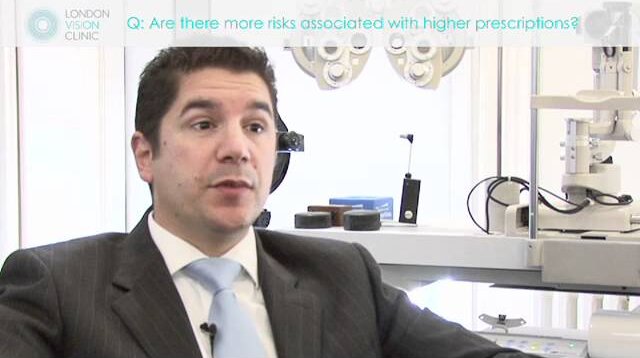Is There a Higher Risk When Treating Higher Prescriptions?

Laser Eye Surgery can truly be a life-changing procedure for people with all types of prescriptions. Nonetheless, when it comes to something as precious as our vision, it is only natural to worry about the potential risks and side effects that may occur. Luckily, Laser Eye Surgery is an increasingly safe procedure that can yield incredible results with little risk. But does this risk increase when treating higher prescriptions? Let’s find out.
As mentioned, Laser Eye Surgery has become increasingly safe and effective since its inception in the 1980s. This is thanks to ongoing developments and innovations, both in surgeon expertise and in the technology we use. All of these advancements have helped to make Laser Eye Surgery – in the right hands – one of the safest elective procedures in the world. However, that isn’t to say there is zero risk of any complications.
Laser Eye Surgery Risks
Generally speaking, most patients can expect to experience some minor side effects following the procedure. The two most common side effects are dry eyes and night vision disturbances.
Dry eyes are common in the days and weeks following Laser Eye Surgery. This side effect can be irritating and inconvenient; however, it is usually effectively managed with the application of lubricating eye drops. These are provided by London Vision Clinic at no extra cost for the duration of your recovery to make your experience as comfortable as possible.
The appearance of night vision disturbances, such as starbursts and halos around light sources, are also relatively common after Laser Eye Surgery. This is caused by swelling in your eyes – but don’t worry! Swelling is a completely normal part of the eye’s healing process and usually settles within a few days to a few weeks after your procedure. As the swelling goes down, night vision disturbances should also subside.
Some people have an increased risk of dry eyes, night vision disturbances and other symptoms following Laser Eye Surgery. However, with the help of a rigorous screening program, your surgeon can create a bespoke treatment plan to mitigate this risk as much as possible.
Other Risks of Laser Eye Surgery
The risk of a serious complication occurring during your procedure is extremely low. For example, according to the National Institute of Health and Care Excellence (NICE), a median of 0.5% (0-20.5%) of eyes treated with PRK, 0% (0-8.2%) of eyes treated with LASEK, and 0.6% (0-3%) of eyes treated with LASIK lost visual acuity (the loss of the ability to read two lines on an eye test chart with best glasses corrected vision).
However, this risk can vary significantly depending on how comprehensive the screening process is and who is performing your surgery. In the hands of an expert surgeon, the chance of something going noticeably wrong is around 1 in 1,000. Furthermore, the chance of an expert surgeon being faced with a situation where they could not satisfactorily correct said problem is even rarer (closer to 1 in 30,000).
Other risks can include the development of astigmatism, which affects around three in every 1,000 patients. Contact lenses can usually correct this form of astigmatism (glasses will not). People who have very high prescriptions have a higher risk of this complication. Astigmatism can happen even if the surgery is perfect, but an inexperienced surgeon or one who does not use the best equipment increases this risk.
Does having a higher prescription put me at higher risk?
Generally, patients with very high prescriptions may be at a slightly higher risk of experiencing side effects and symptoms like those highlighted above. This is because patients with higher prescriptions require more tissue to be removed from the corneal bed to achieve the desired outcomes.
However, as Mr. Glenn Carp notes in the video below, this risk really can only be determined on a case-by-case basis.

Two areas, in particular, where higher prescriptions may represent an increased risk are night vision disturbances (halos and starbursts) and corneal haze.
One of Professor Reinstein’s primary research focuses over the last eight years has been the correction (and prevention) of night vision disturbances. Professor Reinstein has developed protocols for correcting and preventing halo and starburst effects even when treating very high prescriptions and patients with large pupils. Zeiss incorporates many of Professor Reinstein’s findings in the commercially available Carl Zeiss Meditec MEL 80 excimer laser system, which is in use at London Vision Clinic today. It is, therefore, increasingly rare for patients in our practice to end up with night vision disturbances.
Corneal haze is considered a normal part of the eye’s healing process following surface procedures like PRK and LASEK. However, this risk increases with higher prescriptions. The good news is that corneal haze following Laser Eye Surgery generally subsides as the eye heals and has little to no effect on vision.
If the haze is excessive or does not go away, the patient may need additional treatment either with medications or further laser surgery to physically remove the haze – or both. Haze is extremely unusual in LASIK.
To sum up…
So, while patients with higher prescriptions may be at a slightly increased risk of experiencing complications, this risk can often be reduced with the expertise of experienced surgeons using the most up-to-date technology. At London Vision Clinic, we pride ourselves on offering the most thorough screening process which helps us to ensure every patient has the best chance of achieving the very best outcomes – even if they have a high prescription.
The risks of Laser Eye Surgery in your specific case will be discussed in detail at your initial screening. For more information, get in touch with one of our friendly clinic coordinators or Book a Consultation today.


